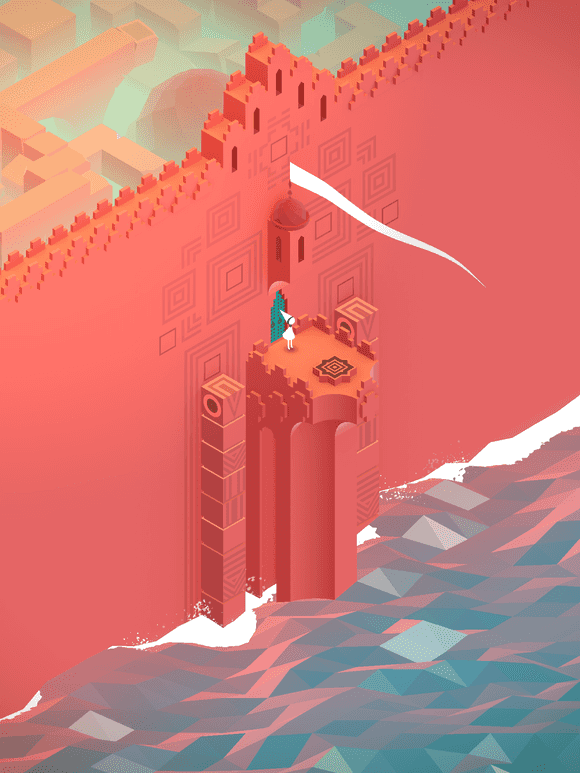Monument Valley - A Review
The beauty of brevity. The pleasure of paradox.

Ten puzzles. Ten gorgeous, mind-bending, paradoxical puzzles. This is a video game you will complete. In fact, Monument Valley may the first video game many will complete. This is by design.
“With so many games, people never see the end, because there’s so many hours of gameplay, we wanted to make a game where you see the whole thing.” - Dan Gray, Monument Valley Executive Producer in an interview with Polygon
As a child, completing a game was a triumph. This was not due to lack time, rather heightened difficulty. Personally, my choice in games was largely based on franchise rather than quality. In turn, this provided me with a library of poorly designed “classics” such as Sonic The Hedgehog and Battletoads. Hours were spent replaying games from Stage 1-1 on to the point where I was forced to power down the console. Check points were few and far between. Save files were non-existent. When asking a video game funding parent if their child had completed any, you’d be hard pressed to receive a positive answer.
I wouldn’t be surprised if this notion has persuaded many audiences away from video games entirely. If they cannot be finished, what is the point?
Now in my late-20s, working 10-12 hours per day, fitting in crucial exercise for a metabolism that seems all but lost, weekends spent running errands that have stacked up, and nurturing a relationship with my soon-to-be wife, I find very little free time to invest in my love for gaming. The minute-to-minute time I do find is spent reading pieces on Polygon or IGN, sharing these with the greater social media landscape. Echoed in Ben Kuchera’s post ”Parenthood makes gaming better by making time your most precious resource,” the value of time skyrockets as we age. The pastimes of yesteryear begin to seem wasteful, yet we strive to retain a connection to our childhood identity. After all, it is the foundation of our dreams. It is who we are and where we are headed.
Since playing Final Fantasy X (recently remastered for PS3 and PSVita) in high school, I have searched for games with rich story. Until the rise of indies, these only seemed attainable through 15-40 hour bouts of character and world building, effectively turning a game into an interactive novel. Fitting one of these epics into my day-to-day has become a near impossible feat.
This is where Monument Valley succeeds. Piling mass amounts of beautiful art and ambitious puzzle design into a bite sized experience is the video game equivalent of a decadent cake. Too much is overbearing. Not enough is unsatisfying. There is a balance.
Monument Valley immediately finds it’s footing through a rich color palette, a soothing soundtrack, and delicate animation. The player understands this world and its inhabitants. The story is used as a mysterious additive that comes secondary to exploring the gorgeous worlds built on paradoxical M. C. Esher design.
Puzzle solving through the discovery of paradox makes the player feel empowered and unstoppable. The experience of breaking illogical boundaries through new perspectives gives players the opportunity to live out their fantasies; it offers a sensation of seeing The Matrix or experiencing the paradox of Inception first-hand.
As the game progresses, the solutions to impossible geometry become more and more difficult to discover. It was not uncommon for me to consciously forget my knowledge of the real world and instead fall back on memories of mazes and Puzzlemania books of my youth. As the difficulty builds, the frustration of adulthood becomes more apparent. Our desire to know how things work is challenged to near breaking point. Even those with a basic understanding of code, animation, and design will scratch their heads and ask of the developers, “how did they do that?” Somehow, the player is able to move the on-screen character through paths that did not previously exist until viewing the vertical world from a different angle. Genius.
It seems the urgency for time has permeated the minds of the developers at ustwo. Monument Valley’s 2-3 hour play-through is the perfect amount of that decadent cake. The experience of Monument Valley is sure to please both the hardcore gamer and casual audiences alike. In fact, it is the perfect example of the importance of short and sweet, possibly introducing these polarizing audiences to a new approach in game design as seen in Journey, The Room, or EDGE. And like that decadent cake, Monument Valley’s length, design, and puzzles are mesmerizing enough to feel satisfied yet haunting enough to warrant constant craving. If DLC is abound, sign me up.
Monument Valley is available exclusively on iOS (iTunes)
Originally published on TheStarrList.com
